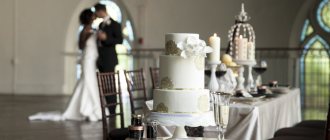It is believed that observing certain wedding signs gives warmth and happiness in family relationships . Age-old traditions are not subject to doubt or discussion, since they are passed on from parents to children. Often, it is the closest relatives who are responsible for the customs, without which the wedding event is incomplete. Undoubtedly, many newlyweds have to look for a compromise.
Photos of the wedding ceremony
Traditions before the wedding
Wedding traditions among different nations have their differences caused by the peculiarities of culture, beliefs, and way of life. But there are also common features. Even in our time, many families celebrate weddings according to the ancient customs of their people, trying to observe as accurately as possible the rituals that have come down from time immemorial.
However, life does not stand still. Many traditions lose their original meaning and become a thing of the past. Modern newlyweds perceive weddings differently than their grandparents. For them, this is a deeply personal holiday, filled with hints, gestures and meaning that are understandable only to two lovers. Mutual feelings come first, and the interests of families remain behind the scenes. But even fifty years ago, many young people got married under pressure from their parents and other relatives!
That is why most of the previously accepted rites and rituals have completely lost their meaning and now look funny and absurd. However, abandoning outdated traditions does not mean at all that the wedding has turned into another boring feast. Quite the opposite! Information technologies available to everyone have allowed newlyweds to collect touching, beautiful rituals and traditions from all over the world, invent something of their own, unusual, creating their own unique wedding scenario. The holiday turns out to be truly original, spectacular and very individual, which is almost impossible to achieve by following ancient customs.
Late
Often the wedding celebration starts late, even though it has been carefully prepared for a long time. According to etiquette, guests being late is bad manners and unacceptable. They should arrive at the place ten to fifteen minutes before the start of the holiday. If guests are late for registration due to unforeseen circumstances, they must sit quietly in the back row, without attracting the attention of others. Be sure to put your mobile phone on silent mode.
Wedding outfit
At different times and among different peoples, the color and style of wedding dresses were strikingly different. Until now, in China, for example, brides traditionally wear a bright red dress embroidered with gold. Once upon a time in Rus', the color red symbolized the beauty of the bride; it is not for nothing that in fairy tales the maidens are all, as if by choice, “red.” But with the advent of Christianity, traditions changed. Initially, white chlamys were worn by girls going to the monastery; they were called “Christ’s brides.” Then the white color of the wedding dress came into worldly life, becoming a symbol of purity and innocence.
Until the revolution, traditions ordered the maiden bride to wear a white dress at her wedding. Even now, most girls cannot imagine getting married without a magnificent white dress, although the original meaning of the ceremony has long been no longer observed. However, the dress can be anything. Modern wedding fashion gives complete freedom in choosing the shade for your outfit. He can be:
- creamy and golden;
- red and blue;
- burgundy and pink;
- green, turquoise and even black.
It is permissible to combine different colors, decorating a white or cream dress with contrasting embroidery, a belt, or lace. Or use a smooth transition of shades of the same color from saturated to lighter ones.
Well, an outfit already worn by someone causes subconscious rejection. An old superstition has taken root too deeply in us, saying that by wearing someone else’s wedding dress, the bride thereby “takes over” the unfortunate fate of her predecessor. Whether this is true or not, science cannot explain. But it is rare that a bride wears someone else’s clothes to her wedding, unless she is absolutely sure that the woman’s marriage turned out to be happy.
Ancient traditions prohibit women who have been married from wearing a white dress. This custom has survived to this day: older ladies prefer all shades of blue or champagne.
Outdoor ceremony: how to prepare
A destination ceremony is one of the most exciting moments for any bride. Before such an event you should eat! It can be something very light, as long as hunger does not occupy all your thoughts during the ceremony.
If there was no ceremony rehearsal and there is no coordinator, then assign one of the bridesmaids to instruct all participants regarding their roles and the entire ceremony program. If there is a coordinator or organizer, then he must do this himself to make sure that everyone is ready. Don't forget to give the celebrant your ring cushion and ring.
Vows, if you agreed to write them individually, must be written and prepared for the ceremony on special “cheat sheets”. Don't neglect them - they will be very helpful if you and your fiancé get worried and forget what you wanted to say. Hug your dad, who will lead you to the altar, and forward - towards a new life!
WEDDYWOOD PARTNERS
During the ceremony itself, try to turn to yourself and your feelings, to the warm gaze of the groom, do not think too seriously about how to stand and where to look, just control yourself a little. Still, the most important thing now is sincerity.
After the ceremony, congratulations and flowers await you. If possible, ask someone to help with the bouquets that guests will give, otherwise you risk not being able to withstand their total weight. Try to pay attention to everyone, and also take photos with everyone - during the banquet you may simply not have enough time for this.
Wedding ceremony: what needs to be taken into account?
Save Saved
Save Saved
Save Saved
What does the veil symbolize?
Today's light, almost weightless, veil is a modified veil that was used to cover brides from head to toe. In Ancient Rome and Greece, people covered themselves completely in a veil, with the exception of the face. According to historians, it was bright yellow and was intended to scare away evil spirits. Some believe that such an inconvenient addition to the festive outfit served as a serious obstacle to the girl’s escape from the aisle.
Russian traditions at a wedding required that girls in a wedding dress be wrapped in heavy, opaque pieces of fabric with elegant embroidery. This procedure symbolized the death of the bride for her family, and the ritual of removing the veil in the groom’s house revived her for a new family.
In the East, a veil was not placed on the bride's head. A weightless, translucent piece of silk was kept between the young couple so that they could not touch each other until the moment of privacy in the bedroom.
Modern wedding customs are quite democratic. If fifty years ago a girl did not dare to wear a veil to a wedding, if she was not innocent, then today everything depends only on the tastes and preferences of the bride. You can decorate your outfit with a luxurious, long veil, a lace cape-mantilla in the Spanish style, or limit yourself to a modest veil attached to a flirty hat or headpiece. Or you can do without this attribute of an old wedding altogether. Often, instead of a veil, brides prefer to decorate their hair with a magnificent tiara, a wreath of fresh flowers, a hair net, beads and chains, and jewelry.
Seating methods for guests
There are two possible seating options for guests:
- guests sit in a way that suits them;
- The seating chart is prepared in advance and is carried out using banquet cards.
The second method is preferable for two reasons. Firstly, banquet cards serve as additional decor for the wedding table, and secondly, in this case, the possibility of people unfamiliar or uninteresting to each other being at the same table is excluded.
Hosting a bachelorette party
This tradition is many centuries old. The custom prescribed to “see off” the bride with crying and sad, drawn-out songs. The bridesmaids got together on the eve of the wedding, visited the bathhouse together, and helped the bride comb and braid her hair. At the same time, she was enlightened about her new, married life and her responsibilities.
The bachelor party, which today is usually held at the same time as the bachelorette party, appeared relatively recently. Apparently, the grooms and their friends became jealous, and they decided to organize get-togethers in their own circle.
Festive dinner: fun and romantic
The most important, official part of the day is behind us, congratulations, fun and dancing are ahead! But there are a couple more important points waiting for you that you shouldn’t forget about. The beginning of the evening is always congratulations from those closest to you: relatives, parents, friends. And you shouldn't lag behind either. It's time to say “thank you” and give a gift or surprise to your parents.
And there is still a wedding dance ahead. Try to put it in the program at the beginning of the evening, while you still have strength and mood, you haven’t eaten too much, remember the movements and will be able to accomplish everything you plan! If there are any other traditions waiting for you during the evening, make sure that you have all the necessary props for them, and the host has not forgotten about them. And then - enjoy the evening, relax, communicate with guests, dance!
Timing of the wedding evening: main stages
Save Saved
Save Saved
Save Saved
Parental blessing
Blessing the newlyweds for family life is one of the most important stages of an ancient wedding. In the old days, it was unthinkable to get married without the approval of older relatives. It was believed that without parental approval, young people would not see happiness and prosperity in family life. The blessing was given by the parents of the young, or their godparents, and in case of their absence or death, by the most respected senior relatives and guardians. The ritual is divided into two stages.
First blessing
The newlyweds receive it from the bride's parents on the morning of the wedding day. That is, immediately before visiting the registry office or the sacrament of wedding in the church. In the old days, this ritual was performed long before the wedding, on the day when the groom’s matchmakers received the consent of the bride’s parents for the marriage. But today the tradition of matchmaking is practically no longer used. How does the ritual work?
- The young people ask for a blessing from the bride's parents after the groom has paid the ransom for his beloved, passed all the tests that the relatives and bridesmaids could think of, and handed her a bouquet.
- During the entire ceremony, the girl is forbidden to cross the threshold of the house or go outside. It is believed that beyond the threshold the bride no longer belongs to her family, she begins a new life.
- They bless in different ways. An ancient custom prescribes spreading out an embroidered towel, on which the young people kneel. And the parents are holding in their hands an old, prayed-up icon, with which they baptize the newlyweds, saying kind parting words.
- Today you can get by with just good wishes and mutual hugs: parental approval is very important for children, even if they are already quite adults.
By blessing, the parents fully accept their daughter’s chosen one into their family and approve of her choice.
Second blessing
It is given to the young family by the groom's parents. According to established traditions, newlyweds must acquire the official status of a new family by going through the marriage procedure at the registry office, or by getting married in a temple (depending on national and family traditions). Previously, the ritual was performed on the threshold of the groom's house, where he brought his young wife. The action itself almost completely copied the morning blessing, except that the parents chose their own words. Today it is permissible to hold a ceremony at the site of the festive feast - in front of the entrance to a banquet hall, bar or cafe, in a forest clearing or on the shore of the sea, lake, or on board a ship.
Newlyweds who do not want to follow the old canons can include blessing ceremonies in the banquet script. Under the guise of one of the first toasts, parents will talk about the wonderful qualities of their children entering a new life, wishing love and harmony in family relationships, prosperity and prosperity. You can arrange the blessing in poetic form or even put on a small performance, showing children's photos and videos, the story of the newlyweds' acquaintance and love.
Outdated
Getting married in old, new, borrowed and blue
This custom comes from England and dates back to the Victorian era, but some still adhere to it to this day. It says that every bride should wear something:
- from new;
- old;
- borrowed;
- and also blue.
Undoubtedly, the wedding dress was always new
from the old one , which was inherited. If family jewelry is not found, then it is quite possible to use something else, for example, a brooch or a chain from your mother. Such a thing became a symbol of the connection between generations; it carried the warmth of the parents invested in their daughter, which the girl should bring to her new family.
Borrowed items are things that were lent to the happy newlywed by her friends. They are needed as a symbol that next to the married couple and after their marriage there will always be relatives and friends who will provide support and come to the rescue at any time.
As blue , which in turn implies purity, honesty and fidelity, brides often used a garter. It is also a good idea to add the shade in question to your makeup or to your outfit, this could be a satin belt or elements on shoes.
Wedding Dress
Probably many people know that according to a long-standing tradition, the dress of the future wife should be white and new. Snow-white - symbolizes youth and innocence. That is why women who are getting married not for the first time often choose other shades of attire. The new is a kind of new life that begins from the moment of marriage.
The custom of wearing white as a wedding dress came to Russia from Europe, because in Rus' on such a day girls wore exclusively red sundresses, which meant maturity and was consonant with the word beautiful.
Fashion is changeable, so in the modern world, brides are increasingly abandoning a snow-white wedding dress. It was replaced by other sophisticated pastel shades such as champagne, tea rose, ivory and so on. And some even replace dresses with suits or overalls, which is the peak of popularity this season.
Availability of veil
Veils have been used as a wedding accessory for 2 thousand years. For example, in Rome, ladies hid their faces with just such an element, this showed their modesty, mystery and chastity. And only after the wedding was the man allowed to remove such a veil from his beloved. Russian brides, according to this tradition, must first get married wearing a veil, thus declaring their purity and purity. If it came to a second and subsequent marriage, then this naturally became unnecessary.
Of course, these days the custom in question has begun to be treated more simply, and the veil is perceived as a beautiful wedding attribute. After all, you can often see newlyweds with a tiara, headband, wreath or some other decoration on their heads.
Removing the veil
Quite an important, but outdated tradition at a wedding. They turn on a slow composition and at this time the mother-in-law replaces the daughter-in-law’s veil with a scarf. This action meant that the girl was moving from the status of a bride to the new status of a wife.
Bouquet and boutonniere
For a long time, the groom collected the newlywed bouquet on his own, picked it in the field or in his own garden. The modern bride is unlikely to allow her lover to choose a bouquet for her on his own, because it must match her festive outfit, accessories, etc. And since many girls still adhere to the belief that the future husband should not see her dress before the wedding, a priori a man will not be able to choose the right accessory in question.
On the wedding day, the bouquet plays an important role in the redemption. Having passed all the tests, the happy groom gives his chosen one a flower arrangement. Taking it in her hands, she agrees to the marriage, then the girl takes a flower from the bouquet and pins it on her beloved’s chest. This is where another custom came from - the presence of a wedding boutonniere, which was necessarily made up of the same flowers as the bride’s attribute.
Modern newlyweds make bouquets and boutonnieres from all sorts of things, from pine cones, berries, and twigs of dried flowers.
Farewell to single life
A fairly old tradition is organizing a bachelorette party on the eve of marriage. In Rus', girls gathered at the house of their future wife, combed her curls, visited the bathhouse and talked about the trials of married life. They did this in order to protect the bride from damage.
The custom of celebrating a bachelor party with friends appeared relatively recently. Indeed, in ancient times, the groom had to go to the bathhouse alone before the wedding.
How exactly you can celebrate a bachelorette party and a bachelor party, look for the links.
Bless the young
Touching upon the topic of traditions in Russia, of course, one cannot ignore such a long-standing custom as the blessing of parents. After all, according to our ancestors, it was after him that their children would definitely be happy in marriage. Each of the future spouses should be blessed by their mothers or godparents in the morning before the wedding.
Further, the wedding ritual in question will consist of 2 more stages. The first takes place before the painting in the registry office. The bride's parents bless her and the groom, most often this happens in the apartment of the future wife, after the ransom, but before leaving the house. After all, it was believed that a new life for lovers would begin just outside the threshold, which is why the first approval should happen before leaving the parental “nest.” The relatives of the girls wished the young couple a happy married life and uttered parting words, which was a kind of approval of the daughter’s chosen one.
It also happened that a couple received their first parental blessing on the day of matchmaking, but since in our days this tradition has almost exhausted itself, many young people receive approval already on their wedding day.
The second thing the lovers receive from the mother and father of the newly-made husband. It occurs after the registry office, but before the start of the feast. Relatives also give a touching speech and wish them happiness in marriage.
Sometimes the groom's parents can bless their son and daughter-in-law already during the celebration at the banquet. Their words can be in prose, poetry, a beautiful story about their child, and then there must be warm wishes for the family.
Ransom
For a long time, the ransom was exclusively financial in nature; the young man had to prove his worth, as well as demonstrate generosity and show that he did not grudge any money for his beloved. In the modern world, it’s already like a fun game, with funny competitions. Her bridesmaids are preparing. If a man cannot cope with the girls’ tasks, then he buys them off with money, candy, and so on. Of course, this is a purely symbolic amount.
These days, many couples refuse foreclosure altogether. A girl can get ready in a beautiful hotel, and the groom comes to pick her up there with a wedding bouquet and they go together to the registry office.
Showering the newlyweds
There is also such a long-standing tradition as showering, for which they take, for example, grain, coins or rose petals and throw them over the spouses. This ritual was considered a kind of congratulation to the newlyweds and wishing them happy and long years of marriage, financial prosperity and fertility.
This was customary to do when the newly-made family left the walls of the registry office or upon arrival at the banquet hall, where the wedding celebration itself took place.
If you sprinkle:
- Grain, for example, buckwheat, rice or millet, this symbolized the imminent appearance of children.
- With candies in colored packaging they prophesied a sweet life for the young.
- With coins - to material wealth and wealth.
- Paper confetti, rose petals and other beautiful flowers - to romanticism in relationships, love and attention of spouses to each other.
It was considered a good sign if many small children were present when the spouses married, because this foreshadowed a quick addition to the new family.
So you have become acquainted with the wedding customs and traditions of Russia, and now you can plan your celebration with those you like the most. We wish you a beautiful and unforgettable holiday that will be remembered for a long time by both you and your loved ones!
The tradition of bride price
A significant percentage of newlyweds willingly include such an interesting and exciting game as bride ransom into the wedding scenario. They come up with complex competitions and puzzles, various fun challenges, and comic competitions. The groom must cope with all the tasks, or pay off the picky judges with money, sweets, and small souvenirs. Today, ransom is perceived as another wonderful opportunity to have fun at a wedding and make it truly unforgettable.
But the origins of this custom are not at all funny. In ancient times, there was a kind of property qualification for starting a family: only fairly wealthy young people could get married. A man had to provide his family with housing and livelihood. The ransom paid for the bride confirmed that the chosen one was rich enough to get married and raise children. Moreover, in the countries of the East, the bride price paid by the groom to the bride became her personal property, to which only the spouse had the right. In case of divorce, the bride price also remained with the woman. The Slavic peoples also had a tradition of ransom-veno, when the groom, before the wedding, ensured the future of his wife in the event of his death, transferring part of his property to her.
Dating and communication
At a wedding banquet you meet many previously unfamiliar people, belonging to different social strata, with different levels of education and upbringing. For this reason, conflicts of various types may arise during a banquet, especially after drinking alcoholic beverages.
Aggressive attacks and inciting conflicts are not only unacceptable, such behavior at a wedding shows complete disrespect for the newlyweds and other guests. At a wedding, everyone is required to behave with the utmost tact and courtesy towards others. Guests get to know each other and communicate on positive topics. You can have casual conversations with your tablemates on abstract topics. It is not recommended to touch upon religion, politics and nationality. You cannot take the bride or groom aside for a conversation, much less detain them for a long time.
If you have any comments regarding the organization of the wedding, you cannot discuss them with other guests. It is necessary to show respect to the people who tried to make the holiday interesting for you.
Common traditions during a wedding
Wedding traditions in Russia are already established; all the rituals listed below are usually performed.
Wedding rings
Wedding rings symbolize fidelity, mutual love, and devotion to one partner for life. Traditionally, purchasing wedding rings is the responsibility of the groom. The bride should not even see them before the wedding. In addition, signs strictly prohibit trying them on before the wedding, much less giving them into the hands of strangers. Even a jeweler should not touch rings with bare hands when selling - only with gloves or through a cloth.
According to Christian custom, rings should be in the form of simple, smooth hoops, without stones or patterns. There is even a sign that the mirror surface of wedding rings contributes to a smooth, comfortable family life. However, today the long-standing tradition is not carried out so strictly, and you can buy rings decorated with engravings, with precious stones, and exquisite three-dimensional patterns. It is believed that wedding rings cannot be removed until the death of the spouse, and their loss or breakage threatens big problems in family life.
List for a walk and photo shoot
After registration, the newlyweds traditionally go for a walk and a photo shoot. Usually beautiful places are chosen for this: monuments, fountains, parks, simply beautiful landscapes. It is important to think through and agree on the route in advance. To keep guests from getting bored, you will need:
- champagne, wine, other alcohol;
- water and juices;
- disposable cups or glasses;
- disposable plates and forks;
- wine corkscrew;
- napkins;
- snack (sandwiches, fruit, vegetable, meat and cheese slices, sweets);
- garbage bags.
Rituals for wealth and fertility
Everyone knows the custom of showering the young with grain. In Slavic culture, and in most countries of the world, grain is associated with fertility and prosperity. Consequently, by showering the newlyweds with grains after the wedding ceremony, they were wished many years of trouble-free family life, many children, and prosperity in the house.
Nowadays, this spectacular ceremony is held at the exit from the registry office, immediately after the official registration of the marriage, or on the steps of the restaurant, in the presence of all invited guests. If the wedding is held outdoors, the newlyweds walk between two rows of guests to the wedding arch.
What can you shower the newlyweds with?
- First of all, these are, of course, various types of grain, symbolizing numerous, healthy offspring. If you can’t find whole grains, cereals will do: wheat, oats, buckwheat, rice, millet.
- Small candies in bright candy wrappers promise newlyweds a sweet family life.
- Coins are a symbol of prosperity, financial wealth in the house.
- Flower petals (as a rule, these are roses of various colors, from burgundy-red to snow-white, but you can choose any other suitable flowers), multi-colored confetti indicate that the family life of the young should be filled with love, romance, strong emotions and impressions, respect for each other.
To make the ceremony look festive, the material for showering is distributed to guests in beautiful wicker baskets, decorated with ribbons, flower buds, appliqué, or in paper bags, decorated in full accordance with the theme of the wedding.
It is considered a favorable sign if, after the wedding, the newlyweds are greeted by as many people as possible, always with the presence of small children. When the wedding cortege leaves, the children race to collect the scattered coins and candies. For children this is a fun game, and for newlyweds it is a bright wish for the speedy birth of their first child.
Competitions and entertainment
Most of the wedding banquet consists of competitions, games and dances. The guest has the right not to take part in all competitions, but it is better to have fun. During the event, you need to demonstrate sincere fun and good mood. You shouldn’t sit at the table all the time, you need to go out on the dance floor, take part in games, laugh and be happy. Do not turn away from the operator filming the video, do not cover yourself with your purse or hand.
The newlyweds are pleased to know that everyone enjoys the holiday, as evidenced by the activity of the guests and their sincere smiles. Newlyweds are always worried about the quality of the banquet, so your task is to assure them that everything is going well and not boring.
Wedding loaf
The loaf, which was always baked for a wedding in Rus', promised the young couple a prosperous home full of prosperity. Its round shape and golden color symbolized the sun, giving light and warmth, joy in life. The wedding cake was richly decorated with figures made from dough, depicting ripe ears of corn, the sun, pairs of doves or swans, bunches of rowan berries, flowers and leaves - everything that reflects mutual love and family well-being in people's minds.
The loaf was carried out on a clean towel embroidered by the bride herself, meeting the newlyweds on the threshold of the groom's house. It always came with a cup of salt. The young people broke off pieces of bread, dipped them in salt and ate them. The meaning of this ritual is quite simple - they left behind all their sorrows and salty tears, entering a new, happy life. And the size of the broken piece indicated what gender the first-born would be: a girl or a boy. The towel was carefully kept in the young family, as part of the bride's dowry.
Later, another sign appeared related to the size of the pieces: whoever has the larger size will be the leader in the new family.
Time to leave
The time spent in a cafe or restaurant is clearly agreed upon in advance; young people pay money for a certain number of hours, so etiquette strictly prohibits guests from staying longer than a certain limit. Such a departure from the schedule will result in additional financial costs for the newlyweds. If you come to a wedding with your children, keep in mind that the little guests will quickly get tired and you will have to go home earlier than expected. Continuing to be at a banquet with naughty kids who cause inconvenience is bad form.
Throwing the bride's bouquet
In the old days, only the groom was responsible for making a bouquet for his chosen one. After all, these flowers symbolized the strength of his feelings. He could get the rarest, most unusual flower for his beloved, from the tops of the mountains or from the depths of the forest, pick a bouquet of field daisies and cornflowers, or ask/buy luxurious garden flowers. Today this custom is practically not used: the bride chooses a bouquet to match her dress. And, as you know, the groom is strictly forbidden to see his wedding attire until the “X” day.
The most enduring, romantic traditions of Russian weddings are associated with the bouquet and boutonniere:
- the final part of the “bride price”, when, having gone through fire and water, heroically overcoming the obstacles that stand in the way, the groom finally gets to the coveted reward in the person of his chosen one. It is then that he gives her a luxurious wedding bouquet. If a girl accepts the gift, it means she agrees to get married;
- Previously, the beloved would take a flower from the bouquet given to her and give it to the groom as a sign of her favor. The happy chosen one pinned the plant to his suit, demonstrating to the whole world that the bride was going down the aisle of her own free will. Today, it is not customary to violate a perfectly calibrated composition compiled by the best florists. Therefore, the boutonniere is ordered along with the wedding bouquet in advance. But, if you wish, you can observe this beautiful, touching custom;
- Throwing the bride's bouquet into a flock of unmarried bridesmaids is another sacredly observed custom. Rarely is a wedding complete without funny attempts by girls to race to catch thrown flowers. With this gesture, the bride shares her good fortune with her unmarried friends. It is believed that the smartest and fastest lucky woman will get married before the end of the year, and the marriage will be favorable.
At modern weddings, the bride's garter is often thrown along with the bouquet. This custom came to us from Medieval Europe. The groom solemnly and beautifully removes the garter from the bride's leg and throws it to his single friends. The bride must dance with the lucky person who caught her wardrobe item. There is also a sign that this guy will soon be married.
Morning of the bride on her wedding day
It is believed that, according to tradition, the newlyweds should spend the night before the wedding separately. This is a very good idea; before such an important day you need to get a good night's sleep. After all, proper sleep is a guarantee of an excellent mood for both the girl and the guy. Think for yourself, if the bride doesn’t get enough sleep, how lethargic she will be in the morning, and she doesn’t need bags under her eyes at all.
So, the long-awaited morning has arrived. The newlywed had slept the night before and was in a cheerful mood. What to do? Where to start the morning? After all, there is so much more to come! Therefore, the entire preparation plan needs to be thought out in detail so that by the time the groom arrives, the bride will be ready.
Breakfast
Of course, on such an exciting day, food is the last thing the bride thinks about, or even doesn’t take into account at all. But in vain! A healthy, filling breakfast is a must. It doesn't have to be a big meal, just yogurt with a bun or fruit to satisfy your hunger a little.
Hair and makeup
Next in line is beauty restoration. There are several options. You can invite a specialist to your home, but keep in mind that the service will then cost much more. Or you can go to the salon yourself, having previously signed up there. But this option is less convenient.
The bride chooses her hairstyle according to her taste, but in terms of nuances it is better to trust a professional in this matter; he will definitely choose the ideal option for your face type.
The next step is makeup. Ideally, it should not be too bright and catchy, but more delicate; it is better to choose light shades. You can simply apply makeup on your eyelashes and eyelids and lightly powder your face. Lipstick is at your discretion, but do not forget that you will “have” to kiss the groom all day.
Manicure
You need to take care of this in advance so as not to waste precious time on your wedding day. Do not make your manicure bright and provocative, it will look vulgar.
Dress
After the bride has already put on her makeup and her hair is ready, you can move on to the outfit. Of course, you should be helped to put on the dress; usually this is done by a young witness (friend), but if she is not around, then let it be your mother.
If you have a full dress, then the corset should not be tightened too tightly. The bride should feel confident in it and breathe freely. It is not necessary to wear the upper part of the underwear, that is, the bra - the corset will already support your breasts.
Decorations
This is perhaps the final touch in preparing for the groom's arrival.
Many brides choose a small tiara or, less often, a wreath as a head decoration. To prevent it from falling off, you can attach the tiara to your hair with bobby pins. Next are earrings and necklaces. The newlywed chooses them to her taste. Shoes should be with closed toes and heels, as a symbol of a full and happy married life (for those who believe in omens).
Well, that's all, the bride is completely ready. The morning did not pass, but flew by. All that remains is to wait for the groom to arrive and go to the registry office to register your marriage.
First kiss
Initially, the bride and groom kissed for the first time at their wedding, in the presence of relatives, respected elders, and honored guests. It was believed that with a kiss, not only breath is united - the souls of the young are united. A public kiss announced to everyone present that from now on the couple was a single whole.
Today, premarital couples have less chaste relationships. But how exciting is the first kiss in front of all your friends and relatives! It seems to consolidate the rights of young people to each other, adding romance and love to the relationship.
Packing a handbag: a must-have for any bride
Wherever your wedding is taking place, there is a list of things that should definitely be in your handbag on this day:
- - Telephone
- — Passport, license or other identification documents
- — Mirror
- - Handkerchief
- - Matting napkins
- - Comb
- — Hairpins and bobby pins
- — Lip gloss or lipstick (choose a color with your stylist or take a colorless one), powder
- - Nail file
- - Wet wipes
- — Spare stockings or tights
- — Threads to match the dress and a needle, pins
- — Mini-pharmacy: plaster, bandage, painkillers and sedatives
The list is impressive, really! It is worth noting that it is better to entrust such a handbag to a bridesmaid who will be nearby throughout the wedding day. You can add several nice and useful bonuses to it:
- — Hand cream (useful during the cold season)
- — Thermal water (especially in summer)
- — A healthy snack for the bride: a bar, nuts or fruit
- - Perfume
- - Spare shoes (eg ballet flats)
Save Saved
Save Saved
Save Saved
Tradition is bitter at a wedding
Shouts of “Bitter!” calling newlyweds to kiss is a purely Russian phenomenon. At almost every wedding you can hear these cheerful exclamations. Where did this custom come from?
Oddly enough, this word, according to one version of historians, has nothing to do with kissing. Initially, the bride’s duties included honorably serving all guests with vodka or another strong alcoholic drink. Those present took glasses from the tray, giving money or other valuable gifts in return, after which they drank the offering and shouted “Bitter!” as a sign that the drink was really strong and went well.
The second version is closer in meaning to the modern custom: this word was shouted by guests during the kiss of the bride and groom to ward off evil spirits. It was believed that the evil spirits, deceived by the exclamations of the guests, would not harm the newlyweds, because they were, after all, having a hard time. According to the third legend, the guests warned the bride and groom with their exclamations that the wine was bitter and should be sweetened with a strong, sweet kiss.
How to behave after the wedding
The wedding celebration is over and it’s time for everyone to go home. It would seem that you can throw away all the rules of decency and behave as you please. However, don't lose your head.
Guests are required to:
- Refrain from accidentally stealing any souvenirs from the feast. So, spoons and forks that belong to the banquet hall should not be taken with you.
- If drivers with buses are specially hired to transport guests home, guests should sit quietly in the car and wait the necessary time for departure.
- If leaving the celebration is planned much earlier, it is best to politely warn the newlyweds about this, explaining a good reason.
In any case, every good guest who is going to a wedding should, in addition to the gift, take care of having a sense of tact, a good mood and the right topics for communication. And even if you won’t be able to show off your wit and eloquence at the wedding, and the gift will not be as generous as you would like, prudent behavior will be appreciated by the newlyweds and other guests.
The wedding night
The sacrament of the first night ends a long, eventful and emotional wedding day. For an innocent girl this is a very important event, and for the groom it is a crucial moment. The wife is carried into the house in their arms like a newborn baby, because for the new family the young wife has just been born.
In order to confuse the evil spirits, a non-standard place for holding the sacrament was chosen, strange from the point of view of a modern person: a hayloft, a haystack, a barn, a cage under the stairs, someone else's house. Hence the widespread custom of renting hotel rooms or apartments, houses at recreation centers for the wedding night, and also spending it in a very special environment - on board an ocean liner, in another country, on the coast of a tropical island.
Traditions at weddings these days change flexibly at the discretion of the young, because the possibilities for creativity and imagination are truly inexhaustible. You can spend this day in the mountains or at the sea, on the roof of a skyscraper or in unrestrained dancing, surrounded by friends and relatives, or in romantic solitude. Only one point of the program remains unchanged - registration of marriage at the registry office. But it can also be postponed to any other day, so as not to overshadow the personal holiday with officialdom.
Modern
The couple borrowed many newfangled traditions from European countries. Below we list some of them that are already in full use in Russia.
Vows
Probably one of the most touching moments at a wedding is the pronunciation of vows by the newlyweds. This is most often done during on-site marriage registration.
You should prepare your speech in advance, rehearse it and clearly deliver it at the holiday itself. You can come up with an oath yourself or order it on the Internet, in prose or beautiful poetry, the main thing is that it is from the heart.
Sand ceremony
The highlight of your celebration can be a sand ceremony. The tradition is to create a decoration and the so-called talisman of two hearts. You will need a glass flask and multi-colored sand, which can be found in a specialty store or on the Internet. The husband and wife take turns filling the capsule with sand, thus creating a unique design.
sparklers
Instead of an expensive fireworks or fire show, you can arrange a more budget-friendly and no less enchanting finale of your wedding day - the lighting of sparklers.
At the end of the evening, the couple and their guests go outside and light the lights. The newlyweds pass through the “corridor” created by the guests, it all looks very symbolic and beautiful, and the photographs turn out incredibly chic and magical.











